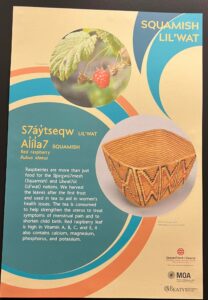
Beaty Biodiversity Museum, Vancouver Campus, Main Mall, Vancouver, BC, Canada
Today we visited the Beaty Biodiversity Museum on campus for our inquiry class. Here are some reflections and thoughts we had during our visit in relationship to our question….
- One story and one experience creates a bias perspective. For example, we discussed the plant “Devils Club”. Different members of our group had different experiences with this plant which invoked very different narratives. For some of us, we viewed devils club through an indigenous lens and saw the plant as a sacred medicinal plant. It is currently known and being researched by UBC to help cure type 2 diabetes, it can kill head lice, be a natural conditioner, and made into creams and teas and so much more. However, from another group members perspective, they saw devils club as harmful and threatening because it can cause seriously dangerous reactions to humans such as serve allergic skin reactions. Today was also a good reminder that we don’t need scientific supported evidence for information to be valid, especially sacred knowledge held by Indigenous community members. Stories are equally as important.
- We also discussed the importance of the visual placement of language especially in western scientific settings. For example, throughout the museum there were various posters with multiple language headings on specific species. Specifically, there is usually one or more Indigenous languages bolded and placed on the top, followed by the English/common name underneath, and lastly the scientific/latin name as well. Having all three languages provides opportunity for various perspectives. We see that having the bolded Indigenous name at the top showcases the centering and importance of Indigenous language, voices, and knowledge. For example, we saw the species of Red Raspberries written in Squamish and Lil’Wat language which is featured in the attached image.
Ultimately, this experience highlighted the importance of different stories and different perspectives for all of us.

Michelle’s update: I went to the Beaty Biodiversity museum on my own time to take a look at the exhibits. I went to find the information about Devil’s club that my group mates were looking at. I have my own memories of Devil’s Club; while tree planting in July, Devil’s Club grew taller than my height and made a jungle out of the cut blocks. We had to walk through the Devil’s club bushes, which send tiny thorns into our skin. The prickles are so small that it felt almost impossible to pull them out. Planting trees in these Devil’s Club jungles seemed like a futile effort; it slowed us down to a snails pace (slow planting=less money), and it seemed that shadowed by the tall plants, the saplings we were planting would not get enough sunlight and die. Due to many different factors (including drought, non-ideal planting conditions, etc.), only 3% of the trees my entire camp planted in the month of July ended up surviving until the next year. To me, Devil’s Club is a reminder of futility.
However, my crewmate told me that he wanted to harvest the red berries growing on the Devil’s Club plants. Apparently, they had medicinal properties. From being at the exhibit, I learned that Devil’s Club helps to treat cancer, bacterial infections, low blood sugar, pneumonia, sores, boils, joint pain, gout and coughs. It can empty the bowels and induce committing when needed. I was surprised at the sheer number of different ailments that it could treat. I really think that these plants could be adapted through research to become even more powerful medicines. If we combined the power and knowledge gained through story with scientific research, amazing strides will be made in medicine. My biases on Devil’s Club are now less prominent; I am in awe about the medicinal benefits.
I also love the Blue Whale display; it reminds me of how small I am and how mighty and majestic the natural world is. I also found the dinosaur track exhibit fascinating. It is crazy how much of a different place the world was a long, long time ago. There are so many stories within the Beaty Biodiversity Museum.

